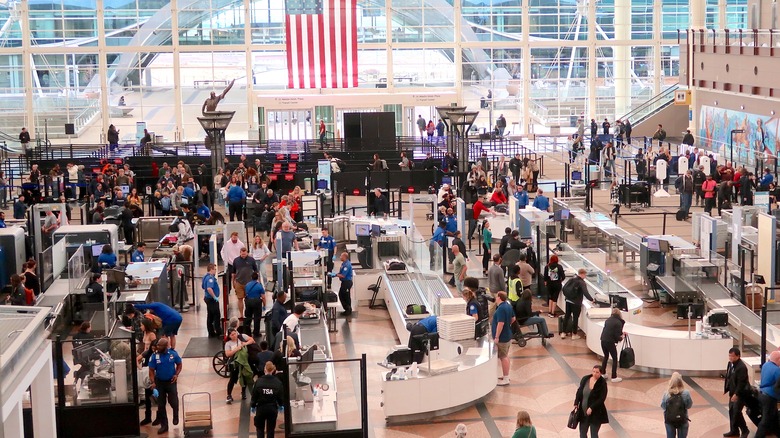The Many US Airports Where You No Longer Need To Show Your Boarding Pass To TSA
Many travelers view TSA unfavorably, often seeing it as a source of frustration at the airport with their relentless reminders to remove shoes, take out electronics, and discard liquids that don't comply with the strict 3-1-1 rule. If you're particularly unlucky, you might even be pulled aside for additional screening. And even if you're savvy enough to apply for TSA PreCheck or Clear to speed through the TSA line as fast as possible, you can still face delays, especially in a bustling airport where everyone and their mother is trying to board a plane.
But here's the kicker: TSA isn't your enemy. In fact, it's actually continuously trying to make everyone's lives easier. In addition to experimenting with self-service screening technology, the agency has also rolled out a system that lets you skip showing your boarding pass to a TSA officer. This relatively new feature is called Credential Authentication Technology (CAT), and it's available at more than 220 airports nationwide.
CAT is exactly what it sounds like — a fancy scanner that authenticates traveler IDs, making boarding passes unnecessary, at least before you board the plane. "Credential authentication technology enhances our detection capabilities for identifying altered or fraudulent documents such as driver's licenses and passports at checkpoints and increases efficiency by automatically verifying passenger identification," Karen Keys-Turner, TSA's Federal Security Director for Pittsburgh International Airport, said in a press release. "The system will also confirm the passenger's flight status in near real time through a secured connection."
CAT units are available in over 220 airports and counting
The TSA hasn't published a comprehensive list of airports using CAT, but the June 2024 press release did indicate that travelers can find it in 228 airports nationwide. A few of these include the Reno-Tahoe International Airport (RNO), Albany International Airport (ALB), Syracuse Hancock International Airport (SYR), Charlotte Douglas International Airport (CLT), and Spokane International Airport (GEG). Just look for the signs in the security area to know if CAT is in play, so you can determine whether to present or stash your boarding pass.
However, keep in mind that this fancy technology is only for travelers 18 and over with valid photo IDs (like a driver's license or state ID). If you're flying with your children, or anyone 17 and younger, remember that they will still need to show a TSA officer their boarding pass, whether in paper or digital form. When scanned, the machine verifies if the passenger indeed has a confirmed ticket for a flight, and if they are enrolled in a Trusted Traveler program, like TSA PreCheck.
According to Airport Technology, this system's magic lies in its built-in tech. It can handle various forms of ID beyond licenses and state IDs, including passports and military ID cards. The ID readers work in tandem with a monitor and UV light to swiftly confirm whether the presented ID is legit. As TSA notes, the result is delivered in near real-time, ensuring the process is quick and efficient.
But don't ditch your boarding pass altogether
Just because TSA has made screening a bit more streamlined at many airports doesn't mean you can toss your boarding pass into the wind. For one, you still need it to board the plane. For another, TSA explicitly states on its website that travelers are still highly encouraged to keep a backup just in case. After all, CAT scanners are still machines, and we all know how reliable technology can be — glitches, unscheduled maintenance, and random technical hiccups are always lurking. As TSA advises, "TSA does recommend all travelers have their boarding pass available in case the TSA officer needs to manually inspect it or CAT is not in use."
What's more, don't be surprised if you end up getting your picture snapped when passing through the CAT units. As of this writing, 84 airports nationwide use CAT-2 machines, which are essentially the souped-up versions of the original CAT units. They not only scan IDs but also snap your real-time photo and match it with your ID for enhanced verification. But don't fret — TSA assures travelers that you're not obliged to have your picture taken, and if you do, your photo won't be stored in their database. So, no worries about your disheveled airport look making its way to places it doesn't need to be.

